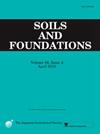Failure mechanics mechanisms and permeability stage evolution of limestone considering wave velocity and failure surface characteristics
IF 3.3
2区 工程技术
Q2 ENGINEERING, GEOLOGICAL
引用次数: 0
Abstract
This research aims to investigate the impact of seepage conditions on the macroscopic and microscopic failure mechanics mechanisms of deep coal seam floor rock mass. The deep coal seam mining floor rock mass in North China has been penetrated by groundwater for a long period in a high-temperature and high-pressure environment, and its mechanical behavior is complicated and diversified. The macro- and micro-mechanical behavior of rock failure under seepage conditions was investigated in this work on deep floor rock strata using experimental methods such as rock mechanics, wave velocity, and nuclear magnetic resonance. The results demonstrate that the original cracks in thin limestone are more developed and have a gully-like structure at the mesoscopic scale than those in Ordovician limestone. According to the nuclear magnetic results, as the confining pressure increases, the initial water-conducting fissures and expanded cracks in the thin limestone may be constricted or closed. Macroscopically, under the action of stress and seepage in different types of rocks, fissures provide the main seepage channels. Due to the confining pressure, the pores are compressed and the permeability decreases significantly. Because rock permeability varies with confining pressure and axial pressure, there is a stress threshold for penetration mutation at each stage. The linear and nonlinear stage evolution characteristics of deep rock permeability and stress with confining pressure are established. The confining pressure affects the internal pore and crack structure of the rock, generating complex seepage network channels and causing changes in permeability properties. The research results provide a scientific foundation and theoretical support for the safe design and sustainable development of underground engineering.
考虑波速和破坏面特征的灰岩破坏力学机制及渗透阶段演化
本研究旨在探讨渗流条件对深部煤层底板岩体宏观和微观破坏力学机制的影响。华北地区深部煤层采场底板岩体长期处于高温高压环境中被地下水渗透,其力学行为复杂多样。采用岩石力学、波速、核磁共振等实验方法,研究了深部底板岩石在渗流条件下的宏细观力学行为。结果表明:薄灰岩的原始裂缝在细观尺度上比奥陶系灰岩更为发育,具有沟壑状结构;核磁结果表明,随着围压的增大,薄灰岩中初始导水裂缝和扩展裂缝可能收缩或闭合。宏观上,在不同类型岩石的应力和渗流作用下,裂隙是主要的渗流通道。由于围压作用,孔隙被压缩,渗透率显著降低。由于岩石渗透率随围压和轴压的变化而变化,因此在每个阶段都存在渗透突变的应力阈值。建立了深部岩石渗透率和应力随围压的线性和非线性阶段演化特征。围压影响岩石内部孔隙和裂缝结构,形成复杂的渗流网络通道,引起岩石渗透性的变化。研究成果为地下工程的安全设计和可持续发展提供了科学依据和理论支持。
本文章由计算机程序翻译,如有差异,请以英文原文为准。
求助全文
约1分钟内获得全文
求助全文
来源期刊

Soils and Foundations
工程技术-地球科学综合
CiteScore
6.40
自引率
8.10%
发文量
99
审稿时长
5 months
期刊介绍:
Soils and Foundations is one of the leading journals in the field of soil mechanics and geotechnical engineering. It is the official journal of the Japanese Geotechnical Society (JGS)., The journal publishes a variety of original research paper, technical reports, technical notes, as well as the state-of-the-art reports upon invitation by the Editor, in the fields of soil and rock mechanics, geotechnical engineering, and environmental geotechnics. Since the publication of Volume 1, No.1 issue in June 1960, Soils and Foundations will celebrate the 60th anniversary in the year of 2020.
Soils and Foundations welcomes theoretical as well as practical work associated with the aforementioned field(s). Case studies that describe the original and interdisciplinary work applicable to geotechnical engineering are particularly encouraged. Discussions to each of the published articles are also welcomed in order to provide an avenue in which opinions of peers may be fed back or exchanged. In providing latest expertise on a specific topic, one issue out of six per year on average was allocated to include selected papers from the International Symposia which were held in Japan as well as overseas.
 求助内容:
求助内容: 应助结果提醒方式:
应助结果提醒方式:


